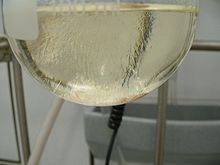Crystallization

When crystallization is referred to the physical process of hardening in the formation and growth of crystals . During this process, heat of crystallization is released. When growing crystals , artificial conditions are created under which crystallization can take place more quickly.
Crystals can arise in a solution , a melt , a gas phase , an amorphous solid or also through recrystallization from another crystal. The initial crystal formation on a crystal nucleus is followed by further crystal growth . The formation of the typical structure is called " crystal loblastesis ".
procedure
In order for a crystal to form, the substance to be crystallized must first be brought to supersaturation . This is done, for example, through the cooling processes of solutions or melts , or through evaporation of the solvent . In the case of crystals that consist of several components ( e.g. ionic crystals ), supersaturation can also be produced by mixing two solutions, each containing one of the components. It is also possible to reduce the solubility of the components that have already been dissolved by adding a third component and thus to generate supersaturation.
The previously dissolved molecules , ions or atoms arrange themselves in a regular, sometimes substance-specific form on a crystallization nucleus and form a nucleus , which then continues to grow in the supersaturated solution. The crystal formation can therefore be accelerated if seed crystals are added as crystal nuclei.
The crystals can then be separated from the solution by filtration , flotation , centrifugation or sieving . An example of the production of a mass product through crystallization is the production of salt in salt pans .
Fractional crystallization
The fractional crystallization is a method for separating substances. A mixture of substances (e.g. two or more isomers ) is dissolved in a suitable solvent by heating. Subsequently, by cooling this solution or by slowly evaporating the solvent, a supersaturated solution is produced from which a substance preferably crystallizes.
In some cases, a separation of enantiomers is even possible, i.e. the separation of the two enantiomers of a chiral substance. Another special case of fractional crystallization is falling film crystallization .
See also
- Johnson-Mehl-Avrami-Kolmogorow equation
- Crystallization (polymer)
- Storm glass
- Single crystal
- Van Arkel de Boer method
Web links
- Crystallization in physical material properties (pdf) (185 kB)
- Ice Crystals Growth (Time Lapse Video)
Individual evidence
- ↑ Chemical reactions - physical processes
- ^ A. Mersmann, Ed .: Crystallization Technology Handbook , Marcel Dekker Inc., New York 1995.
- ^ Axel Kleemann , Jürgen Martens: Optical Resolution of Racemic S- (Carboxymethyl) cysteine , Liebigs Ann. Chem. 1982 , 1995-1998.

